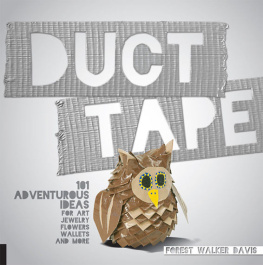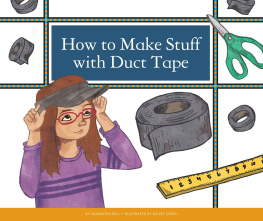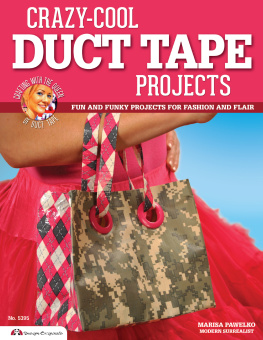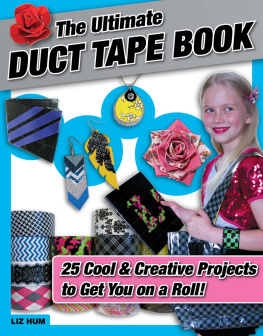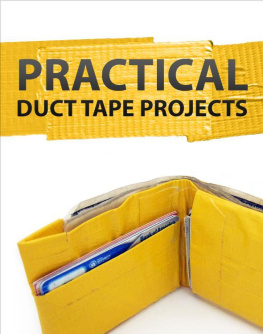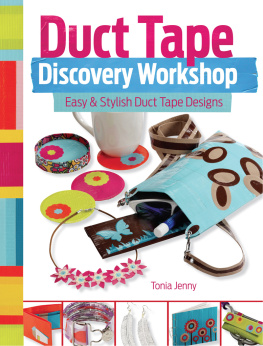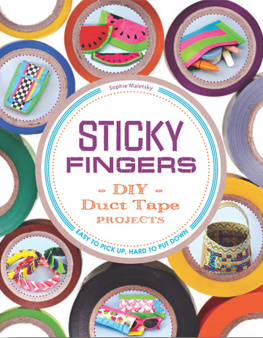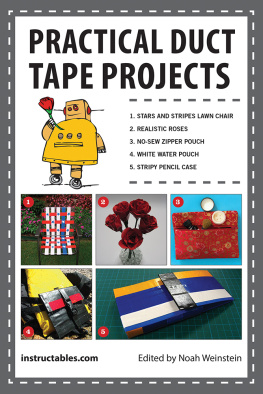DUCT TAPE
101 ADVENTUROUS IDEAS
FOR ART JEWELRY FLOWERS WALLETS AND MORE
FOREST WALKER DAVIS

CONTENTS
FOREWORD
I know this has happened to you.
You spot it from across the store: perfect, bright, and colorful rolls, neatly stacked or playfully jumbled in an oversized bin. Its eye candy drawing you in, and the need to touch it overwhelms. At first you dont know what it is, but then after picking up a roll, you find yourself smiling. Ah, duct tape.
A second realization sinks in as you toss the roll into your shopping basket and head to the check-out counterand this makes you chuckle. Youre in a pharmacy! Along with the sunscreen and variety pack of bandages, youre buying a roll of hot pink duct tapeand for no apparent reason.
Duct tape is everywhere these days. Once, during an intense three hours of running errands, I came across it at the hardware store, the supermarket, my local toy store, and (yes) the pharmacy. It wasnt even on my list of to-dos. As a duct tape artist, its ubiquitous presence is extremely convenient. I may not even realize that Im running low on a particular color or pattern until I accidentally walk down an aisle and see it.
Duct tape is a diverse medium for creativity. It can be used to make wallets, bags, banners, garments, jewelry, belts, and other accessories. It can be folded, cut, and molded into various shapes for 2-D or 3-D art. Duct tape can be a substitute for fabric, paper, markers, and paint. Ive even witnessed someone trying to crochet with it. While most people would snicker, I silently cheered her on. (Go, lady, go!)
The projects in this book showcase the power of duct tape. Forest understands that its not just an adhesive. Duct tape is meant to be played with, to be manipulated and fine-tuned, and to be transformed. There seems to be no limit to what a person can create, whether its art or craft, or something in between. And you can be an old, married lady with kids or a young bachelor with the world at his feet. Forest and I are two very different people, but we shape our inspiration through duct tape. And because of this, we are kindred spirits.
RICHELA FABIAN MORGAN
INTRODUCTION
DUCT TAPE AS ART
I WISH I HAD A GOOD ORIGIN STORY. OTHER ARTISTS I KNOW CAN TALK ABOUT THE FIRST TIME SOMEONE GAVE THEM A PAINTBRUSH OR A CAMERA, ABOUT LEARNING TO SEE COLOR AND SHADOW AND LIGHT. HOW DID YOU GET STARTED? IS PROBABLY THE MOST COMMON QUESTION I GET ASKED, AND MORE THAN A DECADE LATER, I STILL DONT HAVE A SATISFACTORY ANSWER. SOMETIMES I JOKINGLY REPLY THAT I WAS FOND OF GIRLS AND KNEW THAT I WOULDNT BE ANY GOOD AT SPORTS, WHICH IS AT LEAST A LITTLE BIT TRUE.
A better answer is that I always had a creative orientation, was lucky enough to be the son of an art teacher and a musician, and ran into creative people in school who inspired and encouraged me.
I remember somewhere around eighth grade, it became vogue to make wallets and book covers with duct tape. My first wallet weighed about two pounds and had pockets everywhere, hiding notebooks and pencils and playing cards and a pocketknife, but this soon evolved into more portable models. The concept of transforming something blatantly utilitarian into something beautiful appealed to me, as it still does. When I realized that people were willing to pay me five or ten dollars for a duct tape flower, my interest was piqued, but I was (and still am) reluctant to make art for profit, preferring to make things because I feel like they need to be made.
The progression from first wallet through more and more complex artworks to the present day was so slow and gradual that sometimes it feels like one day I woke up like this, teaching art classes, writing a book, and making flowers for weddings. For this reason, its sometimes hard to identify a starting point, or a decision that led me here, but its a pretty nice place to be.
Duct tape occupies an odd place in the world of art. It is often put in an umbrella category such as mixed media or novelty art, and much of the existing material on the subject is marketed toward teenagers, showing the un-seriousness with which it is generally regarded. This un-seriousness, however, is part of its appeal. It allows you, the artist, the freedom to make what you want to make in whatever way youd like to make it. Its unpretentious and simple, a functional and utilitarian thing that people all over the world have elevated in beautiful and unexpected ways, like a gourmet hot-dog stand.
CHAPTER ONE:
GETTING STARTED
ONE OF THE THINGS I ENJOY MOST ABOUT DUCT TAPE AS A MEDIUM IS THE ACCESSIBILITYTAPE CAN BE FOUND AT VIRTUALLY ANY CORNER STORE AND ISNT VERY EXPENSIVE COMPARED WITH OTHER ART MEDIA. IN THIS WAY, ITS VERY DEMOCRATIC. MOST OF THE NON-TAPE MATERIALS ARE SIMILARLY AVAILABLE AND INEXPENSIVE, SO THE BARRIER TO ENTRY IS VERY LOW.
Another thing I like is that it can be done almost anywhere. I feel most comfortable making art in coffeehouses and bars because I think its probably good for me to have some human interaction, and Ive made some good friends and professional contacts that I wouldnt have if I were in my basement working to the sounds of an old Star Trek episode. I try not to take up more space than I need, and if Im occupying one of the few large tables, Ill put up a sign that says nice people may sit here so that I dont feel guilty about overstaying my welcome. Its a good idea to pick tables that are square or rectangular because circular tables make it difficult to make big sheets of tape for wallets and purses and the like. Its also good to find a table that has a smooth, unpainted surface because it gives you a place to set down your strips of tape as youre making them, and the adhesive can remove paint from tabletops, which can anger the owners of the coffeehouse or bar.
TOOLS
Most of the tools I use are simple ones, but I encourage you to use whatever resources you have access to and not feel limited by the manufacturers intent. I recall one particular project in which I needed to carve large pieces of closed-cell foam into smooth shapes suitable for decorating with tape. My father, who inspects beehives, happened to have a specialized tool called a capping knife that looks a bit like an electrified garden trowel. The idea was that the knife would get warm and melt its way through the foam like a heated ice cream scoop. As it happens, this was not very effective, and I went back to using a steak knife. Go forth and find the things that work and learn from the things that dont. That being said, here are the tools I use most frequently.

